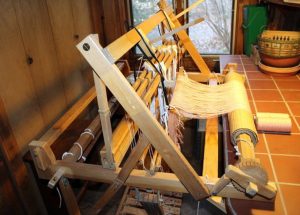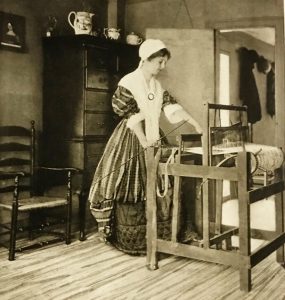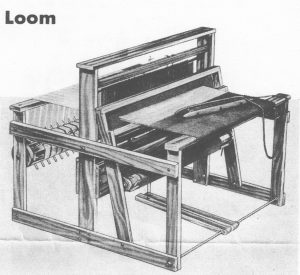Close-up of end of loom with warp around notches and two thick cords at beginning. Red weft thread being pushed or beaten by the heddle.
Media Category: supplement
images for supplements
FH 5 B
Wooden frame with notches on top of vertical ends, threads go through hole in heddle then around notches, then through slot, across heddle. Heddle is suspended or appears to be floating. Threads on each end of heddle are heavier and not part of warp.
FH 1 B
Rectangular length of wood with vertical pieces attached at ends. These pieces have notches cut into the top. Leaning next to it is the wooden heddle with holes drilled and slots cut into it.
Reeds 11 B C Neumeyer
Close-up of reed or sley for old loom. Marked C. NEUMEYER on wooden end.
Reeds 3 B Leinbach.
Close-up of reed or sley for old loom. Marked F. LINBACH on wooden end.
CC Bridgton 2 B brake
Close-up of right-hand side of loom showing one pulley and the hockey-stick-shaped lever that allows the weaver to advance the warp while seated at the loom.
CC Bridgton 1 B
Large wooden four-post barn-frame loom. Overhead beater, two shafts suspended on pulleys, two treadles. Warp goes through a slot on the front crosspiece.
Turned loom B
Example of Leksand style band loom with turned components and decorative painting in red/orange and black.
Painting 1882 cow barn B
Painting from 1882 illustrates the tradition that four young women on a cold winter night would take their band looms and go to the warmth of the cow shed to weave. Young men would join them for socializing.
Medieval imge B
In historic, medieval image, a woman sits in front of a window. She has a white turban on her head and there is a halo behind her. She is weaving on a band loom. There is a shuttle in her lap and she is beating the weaving with a small sword or beater.
Loom parts B
Two vertical wooden pieces are set into bases. Two horizontal pieces fit between them. At the top of the left-hand post are two rollers, one for the warp and one for the woven band. Halfway across the top crosspiece is a short upright with two dowels. The lower one is the heddle dowel and the upper is for the upper warp beam. To the right is a small piece of wood into which fits the rigid heddle. It is attached to the pedal on the bottom crosspiece. On the far side of the upper crosspiece on the left is a small compartment to hold small tools.
Loom circle B
Fifteen wooden Leksand-style band looms are arranged in a circle. They are have the same structure but the color of the wood and some of the turnings are different. The view is from above.
Hand Looms Supp 2020 Order Form rev
Printable (PDF) Hand Looms Supplement order form, through October 2020
school desk 9 B beater
Side view of loom frame shows metal piece attached to bottom of desk. Side piece of beater is hinged from that piece.
school desk 7 B warp spools
Detail of warp beam of loom showing the pre-wound spools.
school desk 3 B front
Chair with cushion attached to metal frame on the floor, other end of frame has metal pole that holds school desk. On top of desk is loom frame, with warp spools at back on right side, warp threads going through a reed; middle posts support a bulletin board and fluorescent light; treadles are attached to metal frame on the floor.
Mary Black loom 3 B BG label
Metal label reads “Devereux Loom
Devereux Mansion Workshop
Marblehead, Mass. U.S.A.”
Mary Black loom 1 B BG
Wooden loom frame is painted green, six treadles visible; beater and reed frame painted red; apron to which the warp is attached shows threads just coming over breast beam. Cones of yarn can be seen on shelves in background.
DM loom 1 B
A diagram with measurements of a small floor loom with square lower frame; six treadles; beater and reed hinged on the bottom; two posts at the middle of frame have a bar across that rolls and holds the cords that are attached to the four shafts.
Barbour booklet 3 B cover
Printed cover of booklet titled “Directions for The Barbour Linen Loom [1906],” picture shows woman sitting on bench in front of small loom lifting the heddle that holds the threads.
Barbour 11 B side view Fig 1
Square wooden frame with round beam on right side and two round beams on the left.
Barbour 5 B KMS shed
Side view of Barbour loom with small warp tied to warp beam on right and breast beam on left. Heddle is raised to show shed. On inside of loom is the metal Y-shaped mechanism that controls the movement of the heddle.
Hokanson Loom 7 B warp beam brake
A large round beam rests in a holder behind the back vertical support. At the end is a large wooden disk with evenly spaced holes bored into it. A large hole set into one of the holes would set the tension on the warp.
Hokanson Loom 6 B cloth beam brake
Round wooden beam has ratchet at end where it attaches to lower side member of loom. Long wooden pawl holds the beam in place.
Hokanson 5 B overall 2
Large wooden loom with tall the back-support units, a second pair of supports attached to the two sets horizontal side pieces. the upper set being fairly wide. The top horizontal units on each side extend from the back, beyond the secondary support. A pole across them hold two sets of pulleys from which hang the small pieces of wood to which the two shafts are attached. The overhead beater holds the reed. Shorter lower supports hold the breast beam. A partially woven rag piece and warp are on it The lower sides have a board between them in the front to form a bench. A piece of cloth and two sticks rest on it.
two legs Photo 2 B
Warp beam clamped to tile worktable; right side diagonal support beam attached to horizontal piece, holds right end of swinging beater; warp threads waiting to be threaded through heddles on shafts.
Nutting 3 B restoredloom
Small wooden floor loom unwarped. Side view shows beater that is attached at bottom leaning against cloth beam; two treadles attached at front. Two posts along sides hold a rod from which hang two shafts; warp beam has wooden ratchet and pawl.
Nutting 1 B recreations of our foremothers
Old fashioned photograph of young woman in Colonial costume standing in front of wooden floor loom; from side view can see it has two shafts; loom is warped; woman has hand on beater that is attached on the bottom. Background contains a tall wooden chest and a chair.
Sears 10 B simplified 2H drawing
Line drawing of wooden 2-shaft floor loom with two treadles; beater attached at bottom frame, shafts set into castle frame. Shows partially woven warp with a shuttle resting on top.
Sears 9 B rigid heddle IMG_001
Line drawing of rectangular wooden tabletop frame loom with rollers at back and front; rigid heddle held by short posts in the middle. Shows partially woven warp with shuttle in the shed.
GLM 4 B full rear beam
Side pieces of rear section reinforced by flat metal rods. Wooden warp beam divided by pegs, rear beam has built in raddle that aligns with pegs. Metal friction brake on inside of right rear post, metal crank with wooden handle on outside.
GLM 2 B side
Wooden floor loom, counterbalance, with 4 shafts and 4 treadles, beater attached at bottom; shafts attached to castle above. White fabric apron on cloth beam.
HandloomIndex1-20 A
Index to the Handloom Supplement, issues 1-20.
Supplements-CD-insert-2
Cover for Hand Loom Supplement Compilation, issues 1-10
GH box loom 009
Hole-and-slot tape loom with two sets of holes, one above the other. The loom frame is a rectangular box without a top. The the short sides of the rectangle form the front and back of the box and are taller than the long sides. The warp beam is set into supports at the back of the box. The heddle is inset on the front of the box. The top of the piece of wood forming the back side of the box, behind the warp beam, has some decorative woodwork, as does the top of the heddle board. The cloth beam is mounted behind the heddle board, inside the box on one of the lower side walls. Below the heddle there is a horizontal slot in the front board. The slot is in line with the cloth beam mounted inside the loom frame. The loom is warped and there is a shuttle and partially-woven tape at the front of the loom. The tape is not being fed through the horizontal slot below the heddle. The loom is based on examples from European folk-history museums. Built by Fred Hatton.








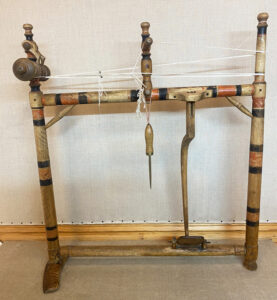



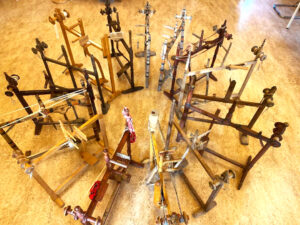







![Cover of "Directions for The Barbour Linen Loom [1906]"](https://spwhsl.com/wp-content/uploads/2020/10/Barbour-booklet-3-B-cover-190x300.jpg)





